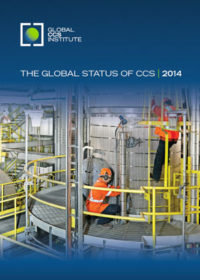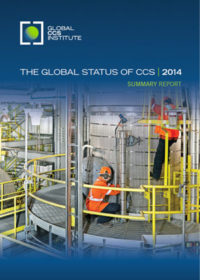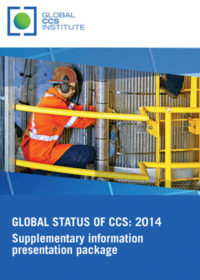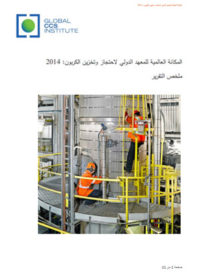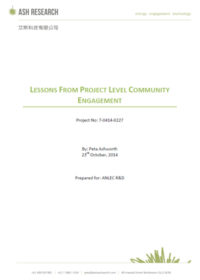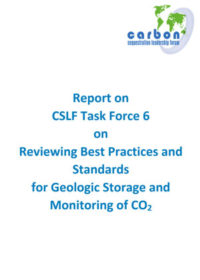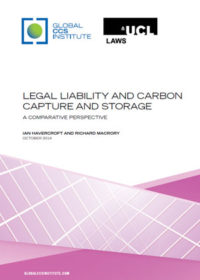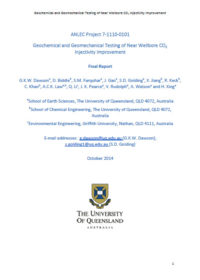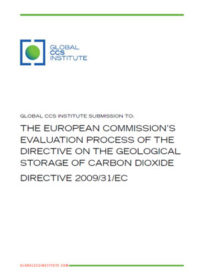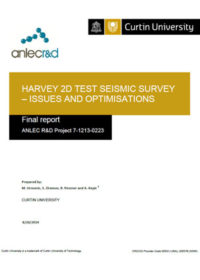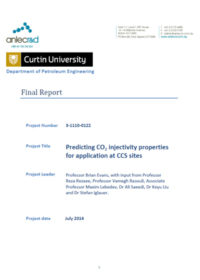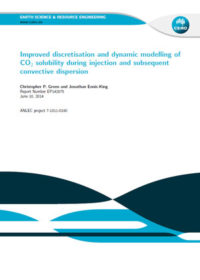Resources
Publications
Our publications, reports and research library hosts over 500 specialist reports and research papers on all topics associated with CCS.
View our Publication Library Disclaimer.
Filter by
The Global Status of CCS: 2014
5th November 2014
Topic(s): Carbon capture use and storage (CCUS), CO2 capture, CO2 storage, CO2 transport, CO2 utilisation
The Global CCS Institute is pleased to announce the release of our Global Status of CCS: 2014 report.
The report provides a detailed overview of the current status of large-scale CCS projects worldwide, finding that 2014 has been a pivotal year for CCS, which is now a reality in the power industry.
For the first time, the report introduces and provides links to project descriptions for around 40 lesser scale ‘notable’ CCS projects. The 2014 report focuses on a number of ‘notable’ projects in Japan.
The Global Status of CCS: 2014 report provides a comprehensive overview of global and regional developments in CCS and what is required to support global climate mitigation efforts. Providing a number of key recommendations for decision makers, The Global Status of CCS: 2014 report is an important reference guide for industry, government, research bodies and the broader community.
Supplementary Information Presentation Package
Disclaimer
The content within the Global CCS Institute Publications, Reports and Research Library is provided for information purposes only. We make every effort and take reasonable care to keep the content of this section up-to-date and error-free. However, we make no claim as to its accuracy, currency or reliability.
Content and material featured within this section of our website includes reports and research published by third parties. The content and material may include opinions and recommendations of third parties that do not reflect those held by the Global CCS Institute.
The Global Status of CCS: 2014 Summary Report
5th November 2014
Topic(s): Carbon capture use and storage (CCUS), CO2 capture, CO2 storage, CO2 transport, CO2 utilisation
The Global Status of CCS: 2014 Summary Report provides an executive overview of the key findings and recommendations contained in the Institute’s Global Status of CCS: 2014 report.
Disclaimer
The content within the Global CCS Institute Publications, Reports and Research Library is provided for information purposes only. We make every effort and take reasonable care to keep the content of this section up-to-date and error-free. However, we make no claim as to its accuracy, currency or reliability.
Content and material featured within this section of our website includes reports and research published by third parties. The content and material may include opinions and recommendations of third parties that do not reflect those held by the Global CCS Institute.
The Global Status of CCS: 2014 Supplementary Information Presentation Package
5th November 2014
Topic(s): Carbon capture use and storage (CCUS), CO2 capture, CO2 storage, CO2 transport, CO2 utilisation
The Supplementary Information presentation package includes chart materials not included in the Global Status of CCS: 2014 report. This material provides additional detail on the status of large-scale CCS projects globally. When used in conjunction with previous status reports, it provides researchers with access to the world’s most comprehensive historical data set on large-scale CCS projects.
Disclaimer
The content within the Global CCS Institute Publications, Reports and Research Library is provided for information purposes only. We make every effort and take reasonable care to keep the content of this section up-to-date and error-free. However, we make no claim as to its accuracy, currency or reliability.
Content and material featured within this section of our website includes reports and research published by third parties. The content and material may include opinions and recommendations of third parties that do not reflect those held by the Global CCS Institute.
المكانة العالمية للمعهد الدولي لاحتجاز وتخزين الكربون | 2014
5th November 2014
Topic(s): Carbon capture use and storage (CCUS), CO2 capture, CO2 storage, CO2 transport, CO2 utilisation
تم البدء بتنفيذ أول مشروع في العالم لاحتجاز وتخزين الكربون على النطاق الواسع في قطاع الطاقة في شهر تشرين الأول من عام 2014 على محطة كهرباء باونداري دام في ساسكاتشوان، كندا. ومن المقرر أن يدخل مشروعان إضافيان لاحتجاز وتخزين الكربون على النطاق الواسع حيز التنفيذ في قطاع الطاقة- في مرفق مقاطعة كمبر للطاقة في ولاية الميسيسيبي ومشروع بترا نوفا لاحتجاز الكربون في ولاية تكساس في عامي 2015 و2016 على التوالي. ويجري أيضاً العمل على أول مشروع في العالم لاحتجاز وتخزين الكربون على النطاق الواسع في قطاع الحديد والصلب، ومشروع أبو ظبي لاحتجاز وتخزين الكربون في الإمارات العربية المتحدة. وهذه المشاريع الأربعة هي من بين 22 مشروع لاحتجاز وتخزين الكربون على النطاق الواسع التي يجري العمل عليها أو تنفيذها في جميع أنحاء العالم- وهو ضعف الرقم الذي كان في بداية هذا العقد.
Disclaimer
The content within the Global CCS Institute Publications, Reports and Research Library is provided for information purposes only. We make every effort and take reasonable care to keep the content of this section up-to-date and error-free. However, we make no claim as to its accuracy, currency or reliability.
Content and material featured within this section of our website includes reports and research published by third parties. The content and material may include opinions and recommendations of third parties that do not reflect those held by the Global CCS Institute.
Lessons from project level community engagement
23rd October 2014
Topic(s): Carbon capture use and storage (CCUS), CO2 storage, Public engagement, Social research
The South West Hub Carbon Capture and Storage Project team, led by the Western Australian Department of Mines and Petroleum (DMP) is committed to an open process of community involvement during all stages of the project. The project team host regular community information sessions and make regular appearances at local agricultural shows. In October 2014 the project team released this report, ‘Lessons from Project Level Community Engagement’ that discusses the impacts and effects of the public engagement program undertaken by DMP.
This report is written by Peta Ashworth, Ash Research, for ANLEC R&D.
Disclaimer
The content within the Global CCS Institute Publications, Reports and Research Library is provided for information purposes only. We make every effort and take reasonable care to keep the content of this section up-to-date and error-free. However, we make no claim as to its accuracy, currency or reliability.
Content and material featured within this section of our website includes reports and research published by third parties. The content and material may include opinions and recommendations of third parties that do not reflect those held by the Global CCS Institute.
Report on CSLF Task Force 6 on reviewing best practices and standards for geologic storage and monitoring of CO2
10th October 2014
Topic(s): Carbon capture use and storage (CCUS), CO2 storage
This presentation is intended for those who want a quick look at available standards, guidelines and best practice manuals to safe and efficient storage of CO2. It is based on the Carbon Sequestration Leadership Forum report Reviewing Best Practices and Standards for Geologic Storage and Monitoring of CO2, an Initial Compilation of Standards, Best Practices and Guidelines for CO2 Storage and Monitoring.
This content has been incorporated into openCCS: Storage, the handbook for delivering carbon capture storage (CCS) projects brought to you by the Global CCS Institute.
Disclaimer
The content within the Global CCS Institute Publications, Reports and Research Library is provided for information purposes only. We make every effort and take reasonable care to keep the content of this section up-to-date and error-free. However, we make no claim as to its accuracy, currency or reliability.
Content and material featured within this section of our website includes reports and research published by third parties. The content and material may include opinions and recommendations of third parties that do not reflect those held by the Global CCS Institute.
Legal liability and carbon capture and storage: a comparative perspective
1st October 2014
Topic(s): Carbon capture use and storage (CCUS), CO2 storage, Liability, Policy law and regulation
Legal liability issues remain critically important for the commercial development of carbon capture and storage (CCS). This co-authored report by Global CCS Institute and University College London largely focusses on the storage aspect of the CCS process. Storage is where the most distinctive liability challenges lie, largely due to the long time-scales involved.
The authors address three types of legal liability:
- Civil liability where third parties who have suffered harm seek compensation or a court order.
- Administrative liability where authorities are given powers to serve some form of enforcement or clean-up order.
- Emissions trading liability where an emissions trading regime provides a benefit for CO2 storage and an accounting mechanism is in place should there be subsequent leakage.
Disclaimer
The content within the Global CCS Institute Publications, Reports and Research Library is provided for information purposes only. We make every effort and take reasonable care to keep the content of this section up-to-date and error-free. However, we make no claim as to its accuracy, currency or reliability.
Content and material featured within this section of our website includes reports and research published by third parties. The content and material may include opinions and recommendations of third parties that do not reflect those held by the Global CCS Institute.
Geochemical and geomechanical testing of near wellbore CO2 injectivity improvement
1st October 2014
Topic(s): CO2 storage
Geochemical and geomechanical testing of near wellbore CO2 injectivity improvement project encompassed three key parts, discussed in this report, aimed at supporting Australian CO2 geosequestration field demonstration and commercial projects.
Lab experiments were conducted on archived and fresh cores from the target formations of the Wandoan CCS project in the Surat Basin, Queensland and Berea Sandstone supplied by ANLEC R&D for the purpose of benchmarking of permeability results across related ANLEC R&D projects.
Geomechanical tests provided the basis for stress/permeability relationships.
Disclaimer
The content within the Global CCS Institute Publications, Reports and Research Library is provided for information purposes only. We make every effort and take reasonable care to keep the content of this section up-to-date and error-free. However, we make no claim as to its accuracy, currency or reliability.
Content and material featured within this section of our website includes reports and research published by third parties. The content and material may include opinions and recommendations of third parties that do not reflect those held by the Global CCS Institute.
Global CCS Institute submission to: the European Commission’s evaluation process of the Directive on the Geological Storage of Carbon Dioxide Directive 2009/31/EC
27th August 2014
Topic(s): Carbon capture use and storage (CCUS), CO2 storage, Policy law and regulation
This submission by the Global Carbon Capture and Storage Institute (the Institute) is in response to the European Commission’s (EC) request for stakeholders to participate in the review of the application of the EU Directive 2009/31/EC (CCS Directive) on the geological storage of CO2 and to provide an assessment of the state of CCS deployment and enabling policy in Europe.
Disclaimer
The content within the Global CCS Institute Publications, Reports and Research Library is provided for information purposes only. We make every effort and take reasonable care to keep the content of this section up-to-date and error-free. However, we make no claim as to its accuracy, currency or reliability.
Content and material featured within this section of our website includes reports and research published by third parties. The content and material may include opinions and recommendations of third parties that do not reflect those held by the Global CCS Institute.
Harvey 2D test seismic survey – issues and optimisations: final report
20th August 2014
Topic(s): Carbon capture use and storage (CCUS), CO2 storage
This study validates the use of smaller sized vehicles to acquire signals in areas where access is not possible by conventional large vehicles in a 3D seismic survey. The study also demonstrated the best sweep characteristics to provide high resolution imaging of the shallow sections and delivered high resolution seismic images for the shallow sediments (<1000m) in the region of the Southwest Hub. The enhanced knowledge of the fault patterns at shallow depths also contributes to improved decision making for planning the next phase of reservoir characterisation activity at the site.
Disclaimer
The content within the Global CCS Institute Publications, Reports and Research Library is provided for information purposes only. We make every effort and take reasonable care to keep the content of this section up-to-date and error-free. However, we make no claim as to its accuracy, currency or reliability.
Content and material featured within this section of our website includes reports and research published by third parties. The content and material may include opinions and recommendations of third parties that do not reflect those held by the Global CCS Institute.
Predicting CO2 injectivity properties for application at CCS sites: final report
1st July 2014
Topic(s): Carbon capture use and storage (CCUS), CO2 storage
In any geological storage project it will be necessary to characterise the reservoir from core samples taken during exploratory drilling. This project uses four co-located specialist laboratories at the Australian Resources Research Centre (ARRC) Perth. It was able to demonstrate the development of a work-flow for unconventional detailed analysis of the reservoir characteristics that can inform decisions and reduce risk in the initiation of a carbon dioxide storage project.
Disclaimer
The content within the Global CCS Institute Publications, Reports and Research Library is provided for information purposes only. We make every effort and take reasonable care to keep the content of this section up-to-date and error-free. However, we make no claim as to its accuracy, currency or reliability.
Content and material featured within this section of our website includes reports and research published by third parties. The content and material may include opinions and recommendations of third parties that do not reflect those held by the Global CCS Institute.
Improved discretisation and dynamic modelling of CO2 solubility during injection and subsequent convective dispersion
10th June 2014
Topic(s): Carbon capture use and storage (CCUS), CO2 storage
Based on the Precipice sandstone of the Surat Basin, this CSIRO study looks at some of the errors generated in the numerical simulation of CO2 migration and dissolution that are caused by the necessity of using large grid blocks in the simulation of field size projects. In the injection stage of a simulation, large grid blocks will cause an overestimation of the amount of CO2 that will dissolve in the formation brine.
The study addresses some of the shortcomings in the scientific literature regarding the effects of coarse grids on the convective mixing process and proposes a scheme for correcting the observed error in the convection enhanced dissolution by using grid corrected fluid or reservoir properties.
Disclaimer
The content within the Global CCS Institute Publications, Reports and Research Library is provided for information purposes only. We make every effort and take reasonable care to keep the content of this section up-to-date and error-free. However, we make no claim as to its accuracy, currency or reliability.
Content and material featured within this section of our website includes reports and research published by third parties. The content and material may include opinions and recommendations of third parties that do not reflect those held by the Global CCS Institute.
